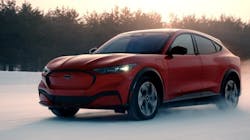An important part of taking care of electric vehicle (EV) owners is knowing and understanding the terms associated with battery range. And that starts with understanding how the U.S. government compares gasoline energy to electrical energy.
The latter is referred to as miles per gallon equivalent (MPGe.) To calculate MPGe, one must do the following - establish the amount of energy (by weight) in a battery cell compared to the same amount of energy (by weight) in the form of gasoline. Then take that amount of electrical energy and see how far you can drive. The distance is your “miles driven on one ‘gallon’ of electricity” and that is your MPGe.
Before MPGe was established, the Feds measured range by how far an EV travels on one charge. Once MPGe was established, range became the amount of energy in a battery pack - listed in kilowatt-hours (kWh) - which is provided by original equipment vehicle manufacturers. Sometimes you will see a label attached to the battery case that states the kWh. Add in some mathematical calculations and you will have a comparison of MPGe versus miles per gallon (mpg).
Just like miles per gallon in the gasoline world, the range of an EV will vary based on how the customer drives, including speed, plus wind, road conditions and outside temperature.
By the way, one big difference between an EV and a hybrid electric vehicle (HEV) is how the car’s cabin is heated. When there is no internal combustion engine (ICE), there is no “free” heat. I’ll elaborate on how cold weather impacts EV batteries later in this column.
Another range-related unit of measurement from the past is “amp-hour” for lead-acid batteries. All these terms can be mind-boggling, but stay with me.
Driving deeper into electric batteries, other battery designs - like those used in cell phones - are still rated in ampere-hours (AH) or milliamp-hours, for example. The AH rating is the amount of steady current that a fully charged battery can supply for 20 hours at 80 degrees Fahrenheit without the cell’s voltage dropping below a predetermined level. For example, if a 12-volt battery can be discharged for 20 hours at a rate of 4 amperes before its voltage drops to 10.5 volts, it is rated at 80 AH. A 100-AH battery will provide 1 amp for 100 hours - or 10 amps for 10 hours.
Some battery manufacturers rate their batteries in watt-hours. The watt-hour rating is determined at 8 degrees Fahrenheit because the battery’s capacity changes with temperature. The rating is calculated by multiplying a battery’s amp hour rating by the battery’s voltage. The watt hour rating of a battery may be listed in units of kilowatts. If a battery can deliver 5 AH at 200 volts, it is rated at one kilowatt-hour.
The kWh is what you will see on plug-in EVs when the HV battery is rated. A plug-in vehicle may display on the dash “miles per 1,000 watts” (1,000 watts is 1Kw) as its “fuel mileage”. Driving 4 miles per Kw is very efficient for a plug-in.
Loss of range in cold weather
In cold weather, all types of vehicles use more fuel, but EVs have a harder time than others. Knowing how to talk with your plug-in electric vehicle (PHEV) and EV customers will help them feel that you “get them.”
Any vehicle with an ICE produces more heat than it needs. The hot coolant - warmed by the ICE - is circulated under the dash in a small radiator called a heater core. Without an ICE, there is very little waste heat, as an EV’s electric motor and large battery will warm up under use, but not enough to heat up the car’s cabin.
In cold weather, the range of a pure EV is reduced as its high-voltage battery is used to make heat. How much range is lost depends on a few factors, but the biggest drain on range is heating the EV’s cabin. The colder it is, the more range is lost.
There are three ways to heat the cabin in an electric car. Number one is to heat up some coolant and use a heater core and a 12-volt fan behind it. Number two is to use high-voltage cables that get hot and then blow air over them. Number three is to use the air conditioner as a heat pump and make hot air instead of cold air. Heat pumps are the most efficient option. If you live in a cold climate and your customer is losing range, now you know why.




